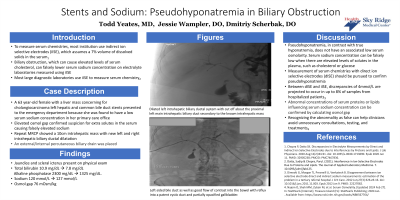Tuesday Poster Session
Category: Biliary/Pancreas
P3560 - Stents and Sodium: Pseudohyponatremia in Biliary Obstruction
Tuesday, October 29, 2024
10:30 AM - 4:00 PM ET
Location: Exhibit Hall E

Has Audio
- TY
Todd Yeates, MD
HCA Healthcare
Lone Tree, CO
Presenting Author(s)
Todd Yeates, MD, Jessie Wampler, DO
HCA Healthcare, Lone Tree, CO
Introduction: Pseudohyponatremia is a false lowering of serum sodium concentration. Biliary obstruction, which can cause elevated levels of serum cholesterol, can falsely lower serum sodium concentration on electrolyte laboratories measured using indirect ion selective electrodes. Recognizing that the measured serum sodium concentration is falsely low can help guide clinicians toward treating the underlying cause.
Case Description/Methods: A 63 year-old female with a medical history of hypertension and liver mass presented to the emergency department at the advice of her primary care physician after she was found to have a low serum sodium concentration in the office. Two months prior, an abdominal MRI with contrast had revealed a T2 hyperintense mass involving the left liver with a central region of necrosis and she had undergone left hepatic and common bile duct stent placement.
In the emergency department, she reported that her jaundice and scleral icterus fluctuate and were worse that day, but she denied worsening abdominal pain or vomiting. She was found to have a serum sodium concentration of 120 mmol/L, compared to 134 mmol/L one month prior. Measured serum osmolality was 329 mOsm/kg and calculated serum Osmolality was 253 mOsm/kg, indicating a large osmolal gap. Abdominal MRI showed Large 10 cm intrahepatic cholangiocarcinoma causing severe left and mild right intrahepatic biliary ductal dilatation with tumor thrombus occluding the left portal vein and partially occluding the main portal vein.
She underwent percutaneous biopsy of the mass and uncomplicated left and right 10 French internal/external biliary drain placement. Her serum sodium concentration gradually increased to 127 mmol/L by the time of her discharge 6 days later. A lipid panel was obtained and revealed a total serum cholesterol level greater than 1000 mg/dL.
Discussion: Pseudohyponatremia, in contrast with true hyponatremia, does not have an associated low serum osmolarity. Serum sodium concentration can be falsely low when there are elevated levels of solutes in the plasma, such as cholesterol or glucose. Measurements using direct ion selective electrodes and measurements of lipoprotein X were pursued but were unavailable at the institution. When there is suspicion for hypercholesterolemia causing falsely low sodium, osmolal gap should be calculated and lipid panel should be obtained. In our patient, the underlying cause of her hypercholesterolemia was addressed, and her measured serum sodium concentration increased.
Disclosures:
Todd Yeates, MD, Jessie Wampler, DO. P3560 - Stents and Sodium: Pseudohyponatremia in Biliary Obstruction, ACG 2024 Annual Scientific Meeting Abstracts. Philadelphia, PA: American College of Gastroenterology.
HCA Healthcare, Lone Tree, CO
Introduction: Pseudohyponatremia is a false lowering of serum sodium concentration. Biliary obstruction, which can cause elevated levels of serum cholesterol, can falsely lower serum sodium concentration on electrolyte laboratories measured using indirect ion selective electrodes. Recognizing that the measured serum sodium concentration is falsely low can help guide clinicians toward treating the underlying cause.
Case Description/Methods: A 63 year-old female with a medical history of hypertension and liver mass presented to the emergency department at the advice of her primary care physician after she was found to have a low serum sodium concentration in the office. Two months prior, an abdominal MRI with contrast had revealed a T2 hyperintense mass involving the left liver with a central region of necrosis and she had undergone left hepatic and common bile duct stent placement.
In the emergency department, she reported that her jaundice and scleral icterus fluctuate and were worse that day, but she denied worsening abdominal pain or vomiting. She was found to have a serum sodium concentration of 120 mmol/L, compared to 134 mmol/L one month prior. Measured serum osmolality was 329 mOsm/kg and calculated serum Osmolality was 253 mOsm/kg, indicating a large osmolal gap. Abdominal MRI showed Large 10 cm intrahepatic cholangiocarcinoma causing severe left and mild right intrahepatic biliary ductal dilatation with tumor thrombus occluding the left portal vein and partially occluding the main portal vein.
She underwent percutaneous biopsy of the mass and uncomplicated left and right 10 French internal/external biliary drain placement. Her serum sodium concentration gradually increased to 127 mmol/L by the time of her discharge 6 days later. A lipid panel was obtained and revealed a total serum cholesterol level greater than 1000 mg/dL.
Discussion: Pseudohyponatremia, in contrast with true hyponatremia, does not have an associated low serum osmolarity. Serum sodium concentration can be falsely low when there are elevated levels of solutes in the plasma, such as cholesterol or glucose. Measurements using direct ion selective electrodes and measurements of lipoprotein X were pursued but were unavailable at the institution. When there is suspicion for hypercholesterolemia causing falsely low sodium, osmolal gap should be calculated and lipid panel should be obtained. In our patient, the underlying cause of her hypercholesterolemia was addressed, and her measured serum sodium concentration increased.
Disclosures:
Todd Yeates indicated no relevant financial relationships.
Jessie Wampler indicated no relevant financial relationships.
Todd Yeates, MD, Jessie Wampler, DO. P3560 - Stents and Sodium: Pseudohyponatremia in Biliary Obstruction, ACG 2024 Annual Scientific Meeting Abstracts. Philadelphia, PA: American College of Gastroenterology.
